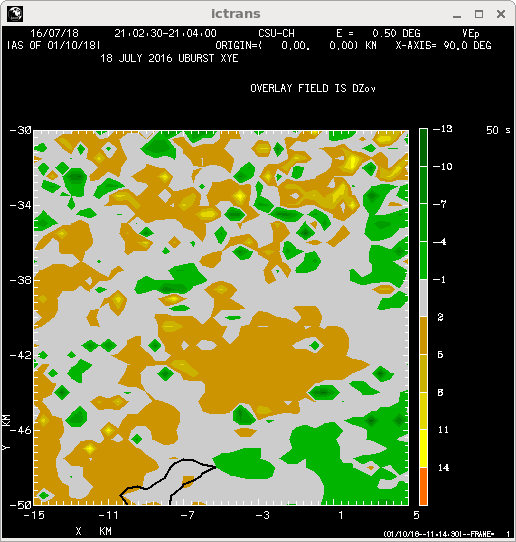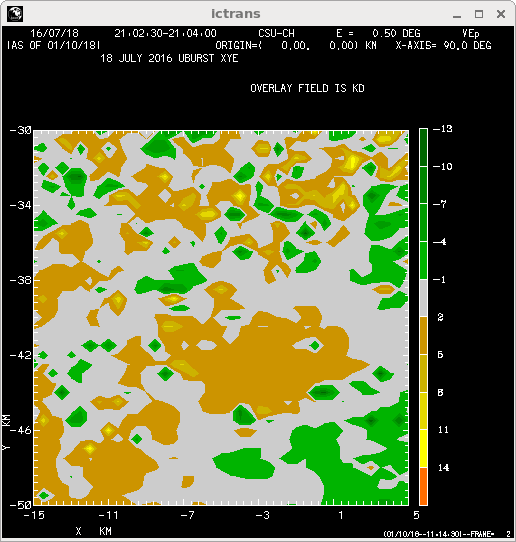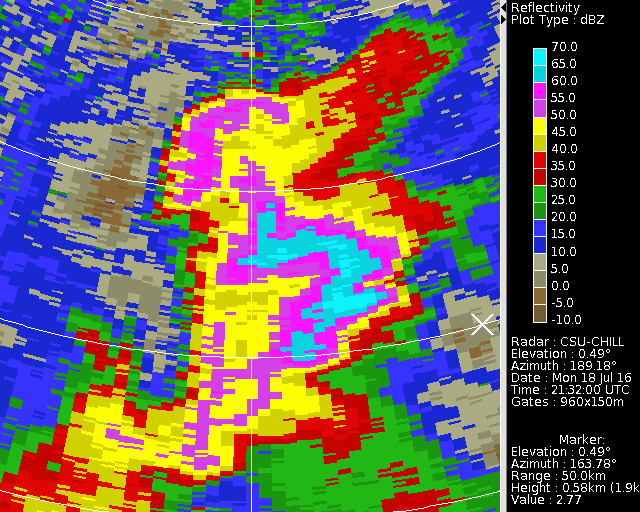DPWX/Downburst evolution: 18 July 2016
Author Patrick C. Kennedy
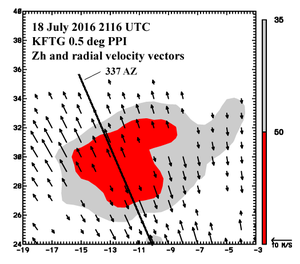
Radial velocity divergence pattern associated with a thunderstorm precipitation shaft in a 0.5 degree elevation PPI scan done by the NWS KFTG radar on 18 July 2016. The CSU-CHILL radar also observed the evolution of this downburst flow field. Time lapse loops of selected CHILL radar data fields have been assembled.
Overview
During the afternoon hours of 18 July 2016, thunderstorms developed in several portions of the CSU-CHILL radar's coverage area. During the 2100 - 2130 UTC time period, 0.5 degree elevation angle surveillance scans were done at time intervals of ~ 3 minutes. These low elevation angle scans captured the evolution of a localized divergence pattern in the radial velocity data generated by one of the thunderstorms. Dual polarization data showed the existence of heavy rain in association with the divergence signature.
The color fill in the following plot shows the radial velocity field at 2120:44 UTC. The data shown in the plot has been interpolated to a Cartesian grid with the points spaced at 500 m intervals in the X and Y directions on the PPI scan surface. The double-ended arrow segment along the CHILL 187 degree radial indicates the divergence signature. The arrow length is 6 km; at this time the divergence pattern size had recently expanded beyond the 4 km size scale that defines a microburst. The black reflectivity contours depict the thunderstorm cell that was generating the low level outflow.
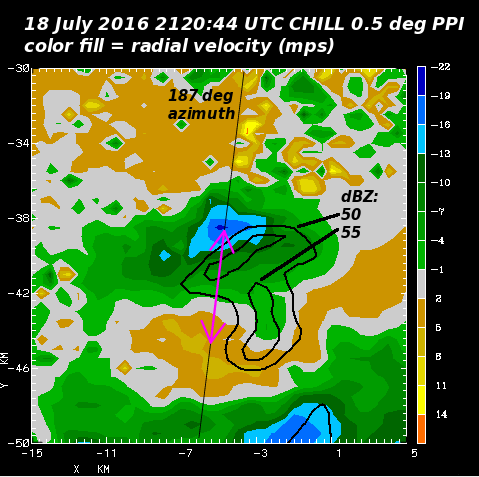
Reflectivity contour overlay
The following loop shows the sequence of 0.5 degree elevation angle CHILL scans for the 2102 - 2130 UTC period. The color fill shows the radial velocity field with negative values indicating radial velocities that are approaching the radar. (The grid origin is the CSU-CHILL radar.) As indicated in the previous overview figure, the downburst pattern developed ~ 40 km to the south of the radar. The solid black contour lines are the 50 and 55 dBZ reflectivity levels. The strengthening of the divergence pattern is correlated with the intensifying precipitation echo.
|
|
||
|
KDP contour overlay
The next loop contains the same radial velocity sequence; the white contour overlay now depicts the 2, 4, and 6 degree per km one-way specific differential propagation phase (Kdp) values. These Kdp levels indicate the presence of significant concentrations of oblate raindrops along the radar beam path. At the CHILL's 11 cm (S-Band) wavelength, a Kdp value of 4 degrees per km implies a rain rate on the order of 150 mm per hour. The water loading and precipitation drag associated with these high rain rates probably augmented the development of downdrafts and surface outflows in this echo system.
|
|
||
|
X-band signal extinction
Additional confirmation of heavy rain in the downburst echo system was provided by the data collected with the CHILL's X-band channel. Signal attenuation at the 3 cm X-band wavelength is significantly higher vs. the propagation losses suffered at 11 cm. The final pair of plots overlays the reflectivity at S and X bands at 2132 UTC. (Just beyond the end of the preceding loops). At this time, some of the high reflectivity echos fell into a radial alignment ~40 to 50 km south of the radar. Toggling between the two images with the "Fwd" screen button shows the significant loss of X-band echo coverage in the down-range portion of the heavy rain beam paths. In these areas, attenuation and absorption have have completely extinguished the X-band signal.
|
|
||
|
